Prosper Estieu and Esclarmonde
Friend of my Previous life
In the beginning of my book The Mayor That Was Me I describe how I was told I was reincarnated from somebody called Jules Azéma. I therefore wanted to identify him. I went to the library in my village, housed in the mairie or town hall, to try and find out who he was. I would try and find a local history that might mention his name.
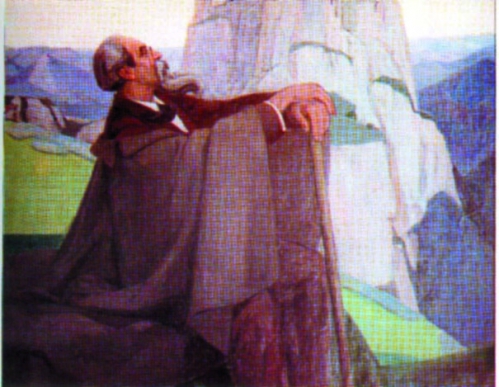 Prosper at the foot of Montségur
Prosper at the foot of Montségur
The first book that I picked up because it looked old, was a red leather-bound volume which I found to contain poems in the Occitan language.
On the fly-leaf was an inscription; To my friend Jules Azéma, in memory of happy days of discussions on the banks of the River Aude. Cordially yours, Prosper Estieu 27 March 1897. It was written in Occitan.
This was heart-thumping time! My previous life had owned this book and it was now in my hands!
Who was Prosper Estieu that he was a friend of my previous life? or of me! 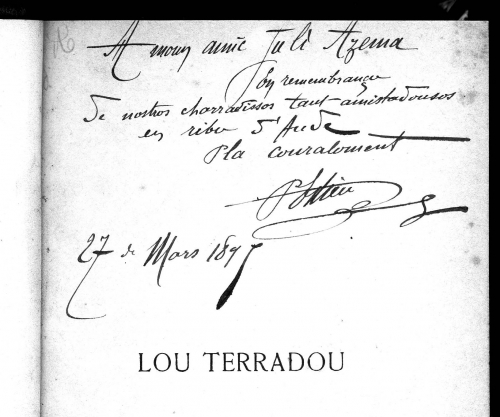
Lou Terradou means my sweet land, or my homeland.
The poems in the book were all sonnets. Each one had a translation in French on the page opposite it, but only a word-for-word translation. In Occitan, a beautifully measured language, every syllable is pronounced, add to the meaning and rhythm.
One of the poems was dedicated to Jules Azéma. It was obvious he and Prosper Estieu were fellow poets. The félibres as they were called, liked to support each other. Le Félibrige was a specific movement, at the time, promoting all things Occitan, especially the language and the poetry. There was also an emphasis on Catharism.
Prosper Estieu was born in 1860 and lived in a village called Fendeille, just to the south of Castelnaudary, but for a time he was a primary school teacher at a village only three miles away from St. Celse, the home of Jules. The inscription above tells us that by 1897 they were friends who spent happy days together.
There was an introduction to the book by Antounin Perbosc. Antounin himself was also a félibre, or Occitan poet. The félibre’s are passionate about their country of Languedoc, sometimes called Occitania. Their poetry is from the heart - they don’t make fun, nor play games with the emotions of their readers.
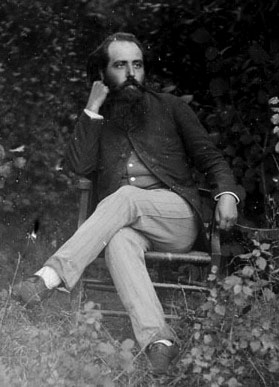
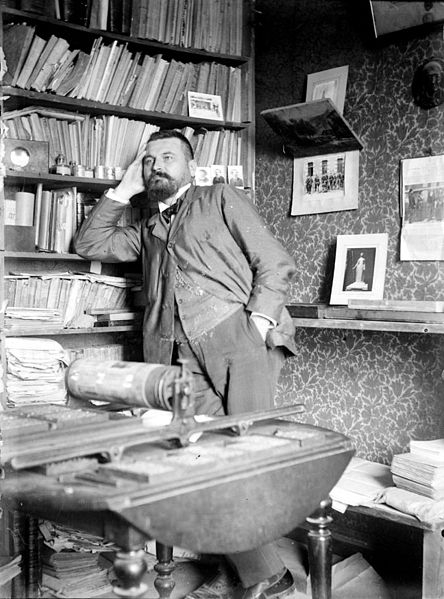 Prosper and Antounin
Prosper and Antounin
On the horizon, the open blue sky was cut in half by the Montagne Noire and by the teeth of the Corbières in the west, while to the south were the snowy peaks of the Pyrenees. In this grandiose setting, looking towards the vast slumbering plain where grew the oats and the rigid maize like spears with blonde tassels, where emerged the oak trees which braved autumn and the poplars beside the low roofs of villages grouped around their clock-tower in a sea of trees, were Castlenaudary, Labécède-Lauragais, Issel, Saint-Martin-La-Lande, Pexiora, Fanjeaux, Miravel-Lauragais, Villeneuve-la-Comptal . . and it is there the poet Prosper wrote his strongest verse, in front of these magical surroundings where, with his eyes turned towards the stones of Naurouze, he heard the sublime voice of Nature. Above all, he remembered all his escapades as a brown adolescent, slovenly and half-wild, the head and feet nude, running across the fields, catching crickets.
What a subtle reference! The félibres often called themselves cigales which means - crickets. The cigales were passionate about their language and culture. After the Revolution all of France was French and obliged to speak French. But the Occitan poets of the Narbonne area would not let their language and culture die. While their Occitan was based on the Provençal of the Felibrige movement started by Frédéric Mistral in 1854, they also took into account the language that the troubadours of Languedoc used in the Middle Ages and up to the 18th century.
The two men who organised and refined this language were Prosper Estieu (1860 to 1939) and Antounin Perbosc. In 1935 Louis Alibert published their Occitan grammar confirming that Occitan was based on the language of the troubadours from the medieval “Courts of Love.” Occitan united a culture of freedom with literature and poetry. The Cathars, the troubadours and the Occitan poets are irretrievably linked by a religion based on love.
Antounin Perbosc tells us; If the Langue d’Oc had been made to stay a poor princess in rags who reigned in the hamlets and villages of our province, could one believe that Roumanille, or Aubanel, a Mistral or a Félix Gras would not have taken it in hand to restore it to its throne of glory? The Queen here has diamonds in her crown; it is the language that Prosper Estieu, an incomparable goldsmith, has reforged on his anvil, as he says in his poem;
Toun obro es lènh d’esser finido; Subre l’enclutge enjouvenido, Ambe vam tournaras laurà! This project is slow to be finished; on the anvil I will rejuvenate it, with courage and style I will turn this work!
Truly, she is Queen, this splendid language of Estieu’s work! She expresses the most subtle sentiments of the soul. She sings like a bird, like a swallow she climbs towards the sun, like an eagle she glides. Exquisitely she tells the words of love, superbly, she proclaims enthusiasms and angers. She is picturesque, the taste, the style, the suppleness, the grace, the harmony. She is all the voices of a Lyre.
Estieu is above all a passionate adorer of form. What magnificence of clear and rich rhymes signifies a sonnet of Prosper Estieu! With his patience and tenacity, with his strange rythyms, he has put his vibrant and passionate soul into Languedocian poetry.
Estieu’s sonnet - “To Occitania.”
Oh my dear country, there you are regenerated! Tired finally of labouring, you are recapturing your rank in a world astonished; the implacable Wolf had you well strangled.
You are sensing the wind of liberty; you are reconquering the inheritance which was stolen from you; it is for that alone that your people wish to be governed; six centuries of oppression had chained you badly.
Yes! They are bursting out anew, your old splendours; each day they grow stronger, the manly trobadours who exalted your name to the heights of Glory.
And the other nations can read tomorrow these letters of gold on your history; this liberator, it is the Roman word, it is your language.
The implacable Wolf was Simon de Montfort; the Languedocian people still talk of him and “the men from the north” as being the enemy. Some Languedocians still think the people of Paris and northern France massacred their people and took their land away from them. Well, they did.
Prosper Estieu dedicated this poem to my previous life in Lou Terradou;
The Widow
With muddy feet, rounded figure and a forehead gilded by the sun, the widow, twenty years old and with eyes so black, in a grassy ditch places her boychild and, as soon as she had him asleep, started work behind a mule.
Me, Petreach inflamed by this beautiful Laura, I would well ten sonnets to have from her a kiss. I told her my passion, but soon I changed my tone; she was chaste, and her voice mixed itself with broken sighs;
“With the soul of my body faithful to my dear buried one, the need for pleasure no more descends on my heart, since my child no longer has a father . . . “
And, while crying she tied up a young vine. Waking up, her beautiful infant lying in the grass smiled at a butterfly.
Amazingly, I discovered who “The Widow” was. I showed a copy of this poem to a French friend who lived in the same village as Jules had done and she became quite disturbed. “It’s my grandmother!” she said. Her grandmother had been widowed twice. The first time she was left with a little boy; then the poem was written sometime before 1897; then she married someone else and had girls, one of whom was my friend’s mother. My friend’s family knew only that Jules and her grandmother were friends and contemporaries in their youth . . .my friend gave me a photo of herself and her grandmother.
Back to Prosper
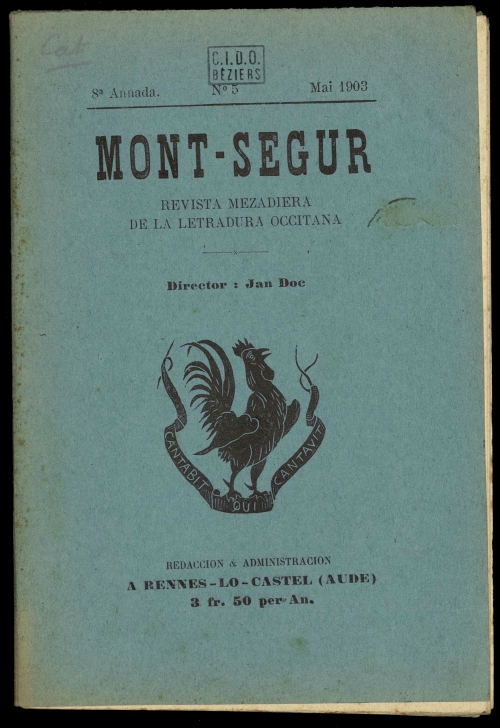 Published from Rennes-le-Château!
Published from Rennes-le-Château!
Meanwhile, the tiny hilltop village of Rennes-le-Château is now known around the world. I have been interested in the Rennes-le-Chateau story for a long time. It was one of those heart-thumping moments when I discovered that Jules’ félibre friend Prosper Estieu was teaching there around 1900. (I believe Jules went to see Prosper there.)
Back in the 19th century Bérenger Saunière was more than ten years renovating his church and held a great party to celebrate it, in June 1897. Then in 1899 came his supply teacher Prosper Estieu from Castelnaudary. In those small villages then the trio of mayor, schoolteacher and priest ran the village. Prosper was described as a “non-religious” teacher; this would have been a left-over from the Revolution, after which religion was dead, but human nature being human nature, it kept reviving. Prosper Estieu passed his Oocitan examinations in 1900 and gained his “Majoral” which means, “appointed,” while at Rennes-le-Château. He was listed among the top 50 of the Félibrige in France. His passion in life was Occitania and the Occitan language, with its great writings and poetry, and he had been writing and teaching Occitan for many years. He founded many “schools” of Occitan, some of which exist today.
In 1900 at Rennes-le-Château, on the 2nd August, Prosper met Déodat Roché, who had such a great interest in the Cathars. Déodat lived at Arques, some fifteen kilometres away and believed he was reincarnated from the great Cathar Perfect, Pierre Authié, who very nearly revived Catharism in the early 14th century, before the Inquisition caught him.
In 1896 Prosper had founded a magazine called Mont Ségur. Many think this was founded by Déodat Roché but Prosper started it and then Déodat joined him after the two men had met at Rennes-le-Chateau. Mont Ségur ran from 1896 to 1899 and then from 1901 to 1906. It looks as though Déodat rescued it, probably financially. In the 1901 and 1902 editions, “Jan D’oc” the Director was Prosper under another name. (My other life also wrote for it.)
Certainly the magazine seemed to have a new lease of life from 1901; the cover changed and it was published from Rennes-le-Château, and continued to be so until August 1903 - two and a half years. The issue dated September/October 1903 was published from Toulouse. Things had changed considerably by then!
Later that summer of 1900 in Rennes-le-Château, Prosper discovered that he had no water. Bérenger Saunière had been taking water from the village water-tank to water his garden, which deprived the school where Prosper was living. The town council, devoted to Saunière, did nothing and eventually Estieu got permission from Limoux for a separate water supply to the school.
On the 22nd July 1902 (Mary Magdalene’s Day) Berenger Saunière wrote to the Prefecture (at Carcassonne) complaining that Prosper Estieu was filling the children’s heads with “excessively progressive ideas” and he was supported by the Mayor. Two against one. It was not settled by the 8th February 1903, for the Mayor then told the Prefecture that Prosper was a bad teacher. I suspect Prosper was teaching the history of Catharism and the Catholics didn’t like it; but teachers weren’t supposed to teach religion, so what they actually accused him of is not known.
In July 1903 - again on MM’s day? - Bérenger Saunière formally complained once again, and Prosper left to go and teach in Raissac-sur-Lampy, between Castelnaudary and Alzonne.
It is true that Prosper was involved in a spiritual scene that must have seemed very heretical to Bérenger Saunière, who was staunchly pro Catholic church and Monarchy.
The whole Occitan liestyle revolved around poetry, ancient languages, history hidden from the “men from the north” and a great patriotism and love for our land. There’s a hint of old pagan religions and certainly alternative beliefs such as gnosticism and reincarnation. It’s said that Prosper was interested in the Occult, being a close friend of Anne Osmont and acquainted with Monti the magician.
Esclarmonde
This was the time that what is now called neo-Catharism developed. The concept of Catharism changed in the 19th century and was far more romantic, intense, colourful. This began with a writer called Nicholas Peyrat.
Born in 1809 in Ariège, he became a pastor in the Reformed Church of France and was anticlerical, regularly criticising the anti-democratic Catholic establishment. There were many like Saunière who wanted a return to pro-Revolutionary times. I have met friends today who despise the Cathar ideas. It’s interesting that Saunière’s favourite saint was St. Anthony of Padua, who was known as the “hammer of the heretics” for his work in persecuting Cathars.
Nicholas Peyrat was a natural and dramatic writer. In 1870 he wrote a History of the Albigensians that read like a romantic novel. Medieval Languedoc was refined and civilised, a country of music and song which was attacked by barbarians from the north. (Occitan people today agree with this and so do I.) Peyrat wrote about Esclarmonde, a high priestess guarding Cathar treasure and texts, a beautiful preacher, a godmother to other beautiful female Perfects, and a martyr who turned into a dove on the funeral pyre of Montségur.
The cult of Montségur became central to the Occitan culture. Peyrat’s words became a rallying cry for nationalists. From Montségur’s peak this conjuration took wing, under the name of spirit, to make its secret way through the winds, the invisible path through storm; it was this mysterious horseman, mounted on the tempest and the thunder . . .who would regenerate Europe and the whole world.
While it’s true that treasure, possible coins and religious texts, were smuggled out of Montségur, it was not a mythic treasure. But Peyrac weaved his tale; the treasure was taken to Lombrives where lived a large Cathar community. The French army there discovered them and bricked up the entrance so that they perished. (I tried to imagine this - the soldiers getting a cement mixer and laying the bricks one by one and the Cathars just watched and let them do it?) But many believed this atrocity. Prosper Estieu wrote a poem called “The Cave.”
Martyrs, you have suffered an atrocious death; your bones are bleached white in this black tomb; but the Crusades have not conquered your soul. Neither rock nor wall has stopped it; it has come again to inflame the Albigensian country, and it is us, your decendants, who have inherited it.
The Félibrige, started by Frédéric Mistral to promote the revitalisation of the language and literature of old Occitania, now adopted these stories as part of their culture. In the last ten years of the nineteeth cenury “neo-Catharism” was born. Many of the félibres were Republicans and wanted a regional identity for Languedoc, concentrating on the language and music.
Peyrat’s writing reflected the truth many Languedocians feel; their freedom of thought had been crushed by the Crusaders led by the “wolf from the north.”
By the early 20th century, the lady Perfect Esclarmonde had become a shining symbol of a new life and spirituality. The legend says that she turned into a dove during the burning, hence the symbol of a dove that has appeared in Cathar castles. She was seen at séances in Paris and people started claiming they were reincarnated from her. Operas were written about her and films made, each more fantastic than the last.
In 1911, in Esclarmonde’s memory, Prosper Estieu initiated the idea of a statue “to her glory” in front of the castle in her town of Foix and formed a committee which included 50 dignitaries from the region and 40 félibres which included Antounin de Perbosc. It was also supported by the anti-clerical movement and the freemasons. (One can almost smell the sulphur!) It was not only important to remember she was the heroine that organised the resistance of Montségur to the hordes of Simon de Montfort, but also our ancesters and that struggled and fell beside her in the defence of Occitania, said Prosper.
It seemed all was going well; In 1912 he wrote to a friend; This will be the Sainte-Estelle of Foix and Montségur, this great day when we will inaugurate this statue of Esclarmonde. The clay version is marvellously made, we need only to find the money. The sculptor's name was Grégoire Calvet. Sainte Estelle, the star, was the patron saint of the Félibrige.
But “passionate controversy arose.” This was at a time when the 1905 separation of Church and State was still new. Prosper had to defend himself and was accused of mental hysteria. Fréderic Mistral, recently congratulated by the Pope himself for his 80th birthday, decided to back out. The Bishop of Palmiers was strangely against the project. A statement was issued. We reject Esclarmonde because it will only revive the religious hatred of bygone times which is better forgotten. We want unity and peace. By celebrating her, we would exalt an immoral and antisocial heresy!
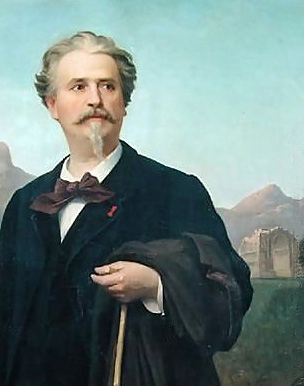 Frédéric Mistral
Frédéric Mistral
Prosper compared Esclarmonde to Joan of Arc; let us not leave forgotten in silence the wicked people of the Church in a past full of horror. The Mayor responded. But Esclarmonde was only a legend! There were many Christian saints to celebrate, not to mention Mary the mother of Jesus!
In his last plea Prosper said; the promoters of this project have no wish to cause indignation or to attack sectarianism, they have done well to glorify Esclarmonde, this Esclarmonde who is the sister of Raymond-Roger (the count of Foix.) We could talk of Esclarmonde de Pereille, a virgin that some might have found sympathetic, who was burned at Montségur in 1244, by the order of the Bishop of Albi, with more than two hundred heros, our ancestors. . . . and have we not at our disposition Esclarmonde d’Alion? Of these three it is Esclarmonde de Foix who is the most representative of our memories and hopes for a re-born Occitania.
The committee added; the clear spirits and the true patriots wish for the success of the great work, without reference to political or religious opinions.
By this time France was unfortunately on the brink of the First World War; and the discussion of the statue of Esclarmonde was never revivied.
Prosper knew his history. Esclarmonde was two people, Esclarmonde the sister of Raymond Roger of Foix, and was ordained as a Perfect in 1204 by Guilabert de Castres at Fanjeaux, and Esclarmonde d’Alion, the wife of Bernard, the Lord of Usson castle, which supported Montségur during the 18th months siege. Their stories were confused and then amalgamated into one.
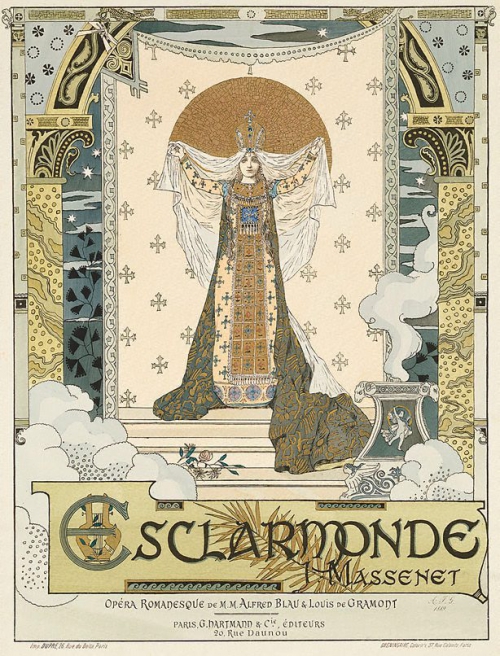 The well-known Massenet wrote an opera to Esclarmonde
The well-known Massenet wrote an opera to Esclarmonde
After the First World War, British spiritualists went to live in Lombrives in the 1920’s and 1930’s, claiming that the Perfect, Esclarmonde, had appeared to them during séances held in London. She had said that she was guarding a sacred stone that had dropped from Heaven at the time the angels had fallen, for one of the principles of the Cathar faith is that the Devil lured the good souls away through a hole in Heaven, which is why they now have to escape their material lives, to get back.
By this time Prosper and Jules were growing old. An old lady who knew Jules told me he and his friends often used to hire a peniche to travel along the Canal du Midi, as far as Castelnaudary. It would have been to see Prosper. Jules died in 1936, Prosper in 1939.
In the ‘30’s an occultist called Joséphin Palédan declared that Montsalvat in Wagner’s opera was Montségur, and these mysteries were suddenly opened to Europe and Otto Rahn arrived to investigate. He proved that the Pyrenean Grail stories were really German stories, and that the Cathars were pure ones as the race of Germans was, and that Esclarmonde’s holy stone fell onto Bavaria, where it is still hidden under a glacier. We do not need the God of Rome . . we do not need the commandments of Moses, we carry in our hearts the legacies of our ancestors. .. we, westerners of Nordic blood, call ourself Cathars, just as easterners of Nordic blood are called Parsees, the Pure. Our Heaven is open only to those who are not creatures of an inferior race, or bastards, or slaves, he wrote.
The “men from the north” were trying to take Languedoc in more ways than one.
I’m glad neither of my Occitan friends saw what happened during that war.
Inscrivez-vous au blog
Soyez prévenu par email des prochaines mises à jour
Rejoignez les 28 autres membres


